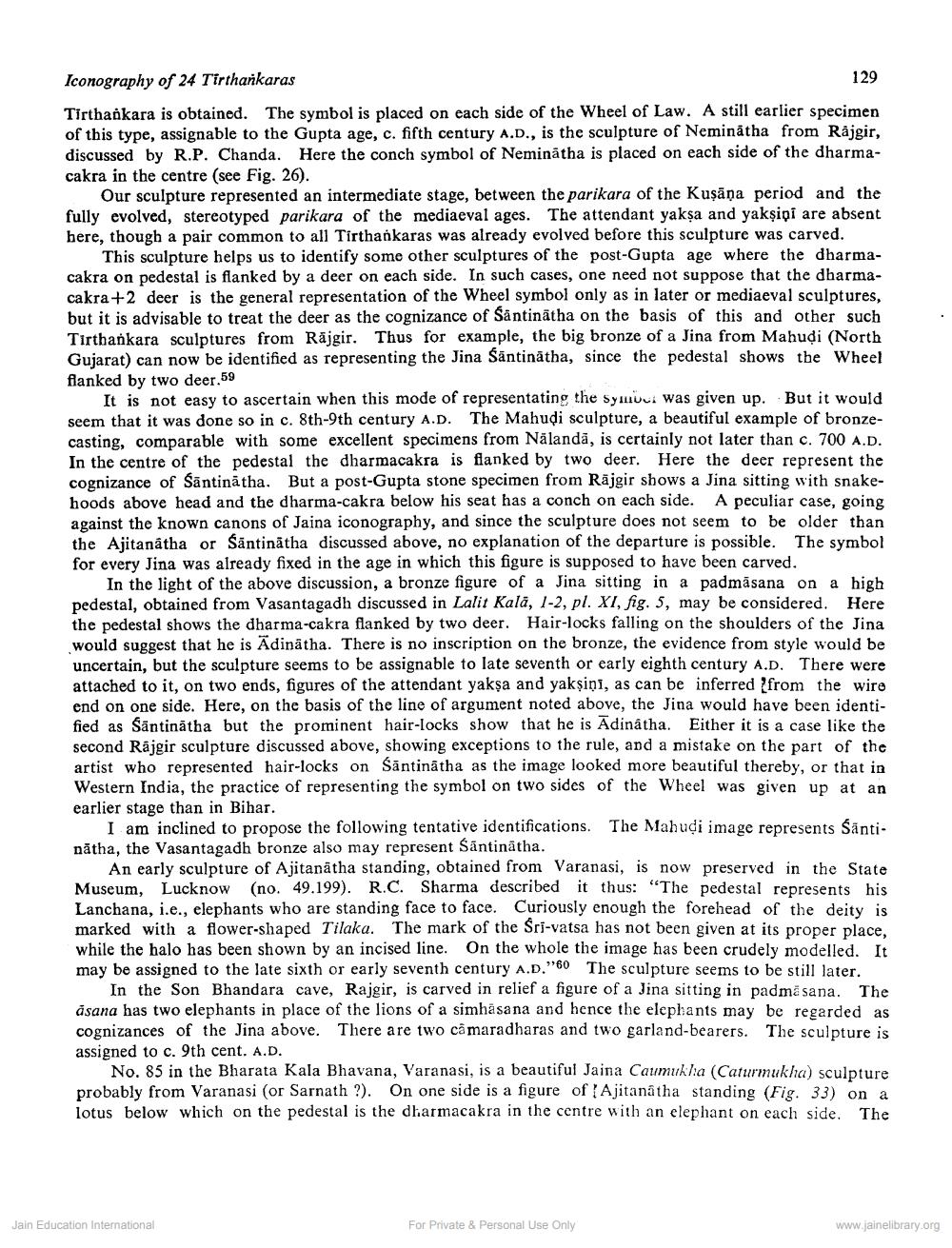________________
Iconography of 24 Tirthankaras
129 Tirthankara is obtained. The symbol is placed on each side of the Wheel of Law. A still earlier specimen of this type, assignable to the Gupta age, c. fifth century A.D., is the sculpture of Neminātha from Rajgir, discussed by R.P. Chanda. Here the conch symbol of Neminātha is placed on each side of the dharmacakra in the centre (see Fig. 26).
Our sculpture represented an intermediate stage, between the parikara of the Kuşāna period and the fully evolved, stereotyped parikara of the mediaeval ages. The attendant yakṣa and yakşipi are absent here, though a pair common to all Tirthańkaras was already evolved before this sculpture was carved.
This sculpture helps us to identify some other sculptures of the post-Gupta age where the dharmacakra on pedestal is flanked by a deer on each side. In such cases, one need not suppose that the dharmacakra +2 deer is the general representation of the Wheel symbol only as in later or mediaeval sculptures. but it is advisable to treat the deer as the cognizance of Säntinātha on the basis of this and other such Tirthankara sculptures from Räjgir. Thus for example, the big bronze of a Jina from Mahudi (North Gujarat) can now be identified as representing the Jina Sāntinātha, since the pedestal shows the Wheel flanked by two deer. 59
It is not easy to ascertain when this mode of representating the Symui was given up. But it would seem that it was done so in c. 8th-9th century A.D. The Mahudi sculpture, a beautiful example of bronzecasting, comparable with some excellent specimens from Nälandā, is certainly not later than c. 700 A.D. In the centre of the pedestal the dharmacakra is flanked by two deer. Here the deer represent the cognizance of Sāntinātha. But a post-Gupta stone specimen from Rajgir shows a Jina sitting with snakehoods above head and the dharma-cakra below his seat has a conch on each side. A peculiar case, going against the known canons of Jaina iconography, and since the sculpture does not seem to be older than the Ajitanatha or Säntinātha discussed above, no explanation of the departure is possible. The symbol for every Jina was already fixed in the age in which this figure is supposed to have been carved.
In the light of the above discussion, a bronze figure of a Jina sitting in a padmāsana on a high pedestal, obtained from Vasantagadh discussed in Lalit Kala, 1-2, pl. XI, fig. 5, may be considered. Here the pedestal shows the dharma-cakra flanked by two deer. Hair-locks falling on the shoulders of the Jina would suggest that he is Adinatha. There is no inscription on the bronze, the evidence from style would be uncertain, but the sculpture seems to be assignable to late seventh or early eighth century A.D. There were attached to it, on two ends, figures of the attendant yakşa and yaksini, as can be inferred from the wire end on one side. Here, on the basis of the line of argument noted above, the Jina would have been identified as Sāntinātha but the prominent hair-locks show that he is Adinatha. Either it is a case like the second Rajgir sculpture discussed above, showing exceptions to the rule, and a mistake on the part of the artist who represented hair-locks on Santinātha as the image looked more beautiful thereby, or that in Western India, the practice of representing the symbol on two sides of the Wheel was given up at an earlier stage than in Bihar.
I am inclined to propose the following tentative identifications. The Mahudi image represents Santinātha, the Vasantagadh bronze also may represent Santinātha.
An early sculpture of Ajitanātha standing, obtained from Varanasi, is now preserved in the State Museum, Lucknow (no. 49.199). R.C. Sharma described it thus: “The pedestal represents his Lanchana. i.e., elephants who are standing face to face. Curiously enough the forehead of the deity is marked with a flower-shaped Tilaka. The mark of the Sri-vatsa has not been given at its proper place, while the halo has been shown by an incised line. On the whole the image has been crudely modelled. It may be assigned to the late sixth or early seventh century A.D."80 The sculpture seems to be still later.
In the Son Bhandara cave, Rajgir, is carved in relief a figure of a Jina sitting in padma sana. The asana has two elephants in place of the lions of a simhasana and hence the elephants may be regarded as cognizances of the Jina above. There are two camaradharas and two garland-bearers. The sculpture is assigned to c. 9th cent. A.D.
No. 85 in the Bharata Kala Bhavana, Varanasi, is a beautiful Jaina Caumukha (Caturmukha) sculpture probably from Varanasi (or Sarnath ?). On one side is a figure of Ajitanatha standing (Fig. 33) on a lotus below which on the pedestal is the dharmacakra in the centre with an elephant on each side. The
Jain Education International
For Private & Personal Use Only
www.jainelibrary.org




